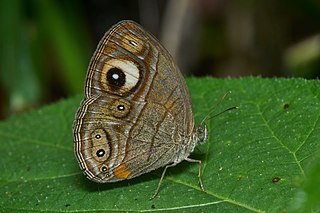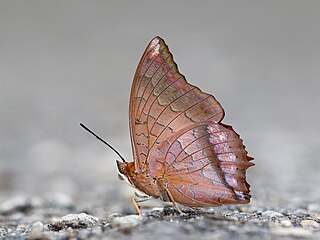
Mycalesis patnia, the glad-eye bushbrown, is a satyrid butterfly found in southern India and Sri Lanka.

Charaxes aristogiton, the scarce tawny rajah, is a butterfly species found in India and Indochina that belongs to the rajahs and nawabs group, that is, the Charaxinae group of the brush-footed butterflies family.

Deudorix epijarbas, the cornelian or hairy line blue, is a species of lycaenid or blue butterfly found in south and southeast Asia from India to Fiji, including the Philippines, and also the tropical coast of Queensland in Australia. The species was first described by Frederic Moore in 1857.

Catocala sponsa, the dark crimson underwing, is a species of moth of the family Erebidae. It is found in Europe, North Africa and from Anatolia up to the Caucasus.

Conistra rubiginea, the dotted chestnut, is a moth of the family Noctuidae. The species was first described by Michael Denis and Ignaz Schiffermüller in 1775. It is distributed in Europe and, according to William Warren, Armenia and Asia Minor.

Mythimna conigera, the brown-line bright-eye, is a moth of the family Noctuidae.

Mesapamea secalis, the common rustic, is a moth of the family Noctuidae. The species was first described by Carl Linnaeus in his 1758 10th edition of Systema Naturae. It is found in Europe, north-west Africa, Turkey and northern Iran.

Trigonodes hyppasia, the triangles or semi-looper, is a moth in the family Erebidae. The species was first described by Pieter Cramer in 1779. It is largely cosmopolitan, found throughout Borneo, Fiji, India, Nepal, Sri Lanka, São Tomé and Príncipe, Taiwan, Thailand, Zimbabwe, northern Australia, and almost all African countries.

The shoulder-striped clover is a species of moth of the family Noctuidae. It is found in most of Europe, Ukraine, southern Russia and southern Siberia, Transbaikalia, Turkey, central Asia, China, Japan, the Korean Peninsula, Mongolia, northern India, Pakistan, the Russian Far East.
Pandemis perispersa is a moth of the family Tortricidae. It is found in north Madagascar.
Pyrausta pyrocausta is a moth in the family Crambidae described by George Hampson in 1899. It is found in the Brazilian states of São Paulo and Paraná.
Pilocrocis fulviflavalis is a moth in the family Crambidae. It was described by George Hampson in 1917. It is found in Peru.
Polygrammodes atricosta is a moth in the family Crambidae. It was described by George Hampson in 1913. It is found on Ambon Island in Indonesia.
Sameodes furvipicta is a moth in the family Crambidae. It is found in Papua New Guinea.
Syllepte tetrathyralis is a moth in the family Crambidae. It was described by George Hampson in 1912. It is found in New Guinea.
Ambia fulvicolor is a moth in the family Crambidae. It was described by George Hampson in 1917 and it is found in New Guinea.
Hoplomorpha teratopa is a moth in the family Oecophoridae. It was described by Edward Meyrick in 1920. It is found in Australia, where it has been recorded from New South Wales.
Aristotelia palamota is a moth of the family Gelechiidae. It was described by Edward Meyrick in 1926. It is found in what was then Bengal.
Semioptila trogoloba is a moth in the Himantopteridae family. It was described by George Hampson in 1920. It is found in Malawi and Mozambique.
Miresa albipuncta is a moth of the family Limacodidae first described by Gottlieb August Wilhelm Herrich-Schäffer in 1854. It is found in Sri Lanka, India and Nepal.








